
|
|
Version
Table of Contents
1.2 What do you need to understand this book 4
3 Installing openCRX for Tomcat 9
4.1 Initial Setup of openCRX Application 15
4.1.1 First Login as “admin-Root” 16
4.1.2 Create Data Segment “Standard” 19
4.1.3 Import Codes and Data 20
4.1.4 Set Access Levels of Codes 21
4.2 Initial Setup of Segment “Standard” 22
4.2.1 First Login as “admin-Standard” 22
4.2.2 Configure Segment “Standard” 23
4.2.3 Create a new Contact “guest” 24
List of Figures
Figure 1: openCRX Login page 15
Figure 2: First login with admin-Root / opencrx 16
Figure 3: Start screen of admin-Root 18
Figure 4: Create a new segment with Actions > Create Administrator 19
Figure 5: Create a new segment named Standard 19
Figure 6: Result of operation Create Administrator 19
Figure 7: Load Code Tables and Data – Step 1 20
Figure 8: Load Code Tables and Data – Step 2 20
Figure 9: Execute Operation Security > Set Access Level 21
Figure 10: Parameters of Operation Set Access Level 21
Figure 11: Result of the Operation Set Access Level 21
Figure 12: First login with admin-Standard / opencrx 22
Figure 13: As admin-Standard start the wizard Segment Setup 23
Figure 14: Wizard Segment Setup - properly configured Segment 23
Figure 15: Refresh homepage of user admin-Standard 24
Figure 16: Fly-in menu 24
Figure 17: New contact guest – step 1 25
Figure 18: New contact guest – step 2 26
Figure 19: New contact guest – step 3 26
Figure 20: New contact guest – step 4 26
Figure 21: New user guest – step 1 27
Figure 22: New user guest – step 2 27
Figure 23: New user guest – step 3 27
Figure 24: New user guest – step 4 28
Figure 25: New user guest – step 4 28
Figure 26: New user guest – step 5 28
Figure 27: New user guest – step 6 29
List of Listings
Listing 1: The file openejb.xml 10
Listing 2: The file server.log.properties 11
Listing 3: The file run.bat 11
Listing 4: The file run.sh 12
Listing 5: Connector definition in server.xml 12
Listing 6: Access Log Valve in server.xml 13
Listing 7: The file tomcat-users.xml 13
Listing 8: Tomcat console output 14
Listing 9: Console Output – Initialization of the openCRX servlet 17
Listing 10: Console Output – Importing Codes and Data 20
1 About this Book
openCRX is the leading open source CRM enterprise suite. openCRX is based on the openMDX application framework, an open source application framework based on the OMG's model driven architecture (MDA) standards, delivering maximum openness, standards compliance and a state-of-the-art component-based architecture.
This book describes the manual installation of openCRX for deployment on Apache Tomcat.
1.1 Who this book is for
The intended audience are openCRX administrators and system administrators who either want to install openCRX manually (for whatever reason) or want to install openCRX on a platform not supported by our openCRX Server installer.
1.2 What do you need to understand this book
This book describes the manual installation of openCRX for deployment on Apache Tomcat. The book assumes that you are familiar with the Tomcat management and administration.
1.3 Tips, Warnings, etc.
We make use the following pictograms:
|
|
Information provided as a “Tip” might be helpful for various reasons: time savings, risk reduction, etc. |
|
|
You should carefully read information marked with “Important”. Ignoring such information is typically not a good idea. |
|
|
Warnings should not be ignored (risk of data loss, etc.) |
2 Prerequisites
As a first step select the openCRX version you want to install. Based on the published version compatibility information you can determine the appropriate versions of openMDX, Tomcat, and Java JDK:
http://www.opencrx.org/faq.htm#versioncompatibility
|
|
Write down the version numbers of the software packages you have chosen to install – this may be helpful in the future in case you require support or want to file a bug report: openCRX v_______ (this guide is based
on openCRX v2.4.1) |
|
|
Throughout the installation of openCRX and related software it is a good idea to avoid paths containing blanks like the default installation directory ...\Program Files\... on Windows. Whenever an installer proposes an installation path containing blanks, please change the path to avoid problems down the road. |
2.1 JDK 5.0
Install the Sun Java JDK 5.0 available from the following site:
Sun JDK
5.0:
http://java.sun.com/javase/downloads/index_jdk5.jsp
|
|
It is not sufficient to have a Java Runtime Environment (JRE) only. The full-blown JDK is required to run openCRX. |
|
|
Don't forget to set the environment variable JAVA_HOME |
2.2 Ant 1.7.0
Download Ant 1.7.0 (available from http://ant.apache.org/) for your platform and install it by expanding the downloaded file to a directory of your choice.
|
|
Ant v1.7.1 might work as well. However, we recommend Ant v1.7.0 (there are some combinations of JDK versions and Ant v1.7.1 that “don't like each other”...) |
|
|
Don't forget to set the environment variables ANT_HOME and ANT_OPS as follows:
|
2.3 openMDX SDK
Download and install the openMDX SDK: http://www.openmdx.org/sdk.htm
Installation instructions are also available from the above website.
|
|
If your platform is not supported by the openMDX SDK Installer, you can install the openMDX SDK on one of the supported platforms and then copy the required files to your target platform. |
2.4 openCRX SDK
Download and install the openCRX SDK: http://www.opencrx.org/sdk.htm
Installation instructions are also available from the above website.
|
|
If your platform is not supported by the openCRX SDK Installer, you can install the openCRX SDK on one of the supported platforms and then copy the required files to your target platform. |
2.5 Apache Tomcat
Download Tomcat 6.0.18
from
http://archive.apache.org/dist/tomcat/tomcat-6/v6.0.18/bin/
This guide is based on Tomcat
v6.0.18:
http://archive.apache.org/dist/tomcat/tomcat-6/v6.0.18/bin/apache-tomcat-6.0.18.zip
(Windows)
http://archive.apache.org/dist/tomcat/tomcat-6/v6.0.18/bin/apache-tomcat-6.0.18.tar.gz (Linux)
|
|
If you want to deploy openCRX on a Tomcat version different from Tomcat v6.0.18, we recommend to build a the files tomcat-juli.jar and catalina.jar matching to your Tomcat version as follows:
|
2.6 Database
Please note that you must set up the openCRX database as described in the respective openCRX database installation guide before you continue. For example, if you want to install openCRX for PostgreSQL, you must first install PostgreSQL and the matching openCRX database definitions.
Database installation guides for the supported database management systems are available from http://www.opencrx.org/documents.htm
|
|
Please remember that you will also need a JDBC driver appropriate for your database management system (please refer to the relevant DB installation guide for additional information). Copy the JDBC driver into the directory TOMCAT_HOME\lib. |
|
|
Please note that this guides assumes that you installed PostgreSQL for DB-specific instructions. If you decided for another DBMS, you might have to adapt some of the commands/instructions accordingly. |
Once you have successfully installed the database you are ready to continue with the Tomcat setup.
3 Installing openCRX for Tomcat
In a first step, install Apache Tomcat by expanding the downloaded file apache-tomcat-6.0.18.zip (or apache-tomcat-6.0.18.tar.gz respectively) to a directory of your choice, e.g. D:\apache-tomcat-6.0.18 on Windows or /opt/apache-tomcat-6.0.18 on Linux. For the remainder of this document we assume that TOMCAT_HOME points to the Tomcat installation directory, e.g. TOMCAT_HOME=D:\apache-tomcat-6.0.18
|
|
On Windows, avoid paths that contain blanks (e.g. the famous C:\Program File\...) as there are all kinds of pitfalls down the road... |
|
|
Make sure that you added JAVA_HOME
to your system environment variables as Tomcat needs the JDK to
compile JSPs, e.g. |
Now we add openMDX and Apache OpenEJB to Tomcat by copying several files from the openCRX SDK to the Tomcat directory structure:
copy the file tomcat-juli.jar from the openMDX SDK installation directory <MDX_SDK_Install_Dir>\openmdx-2.4.1\jre-1.5\core\lib to the Tomcat directory TOMCAT_HOME\bin (overwrite the existing file)
copy the file catalina.jar from the openMDX SDK installation directory <MDX_SDK_Install_Dir>\openmdx-2.4.1\openejb-3\openejb\lib to the Tomcat directory TOMCAT_HOME\lib (overwrite the existing file)

Please note that the files tomcat-juli.jar and catalina.jar are version-specific, i.e. if you want to run openCRX on a Tomcat version different from Tomcat v6.0.18 you need to go back to chapter 2.5 Apache Tomcat and build them.
copy the two files openmdx-base.jar and openmdx-base-ext.jar from the openMDX SDK installation directory <MDX_SDK_Install_Dir>\openmdx-2.4.1\jre-1.5\core\lib to the Tomcat directory TOMCAT_HOME\lib
open the ZIP file <MDX_SDK_Install_Dir>\openmdx 2.4.1\ repository\distribution\ openmdx-2.4.1-openejb.openejb-3.zip and copy the file openmdx-openejb.war - located in the folder openmdx-2.4.1/openejb-3/openejb/deployment-unit - to the Tomcat directory TOMCAT_HOME\webapps and then rename it to 0 openmdx-openejb.war (Tomcat must load it as the first WebApp)
Next we install the openCRX enterprise archive:
create the directory TOMCAT_HOME\apps
copy the file opencrx-core-CRX.ear from the directory <SDK_Install_Dir>\opencrx-2.4.1\jre-1.5\core\deployment-unit to to the Tomcat directory TOMCAT_HOME\apps
Next we configure the database connection (and optionally a mail resource):
create a new file TOMCAT_HOME\conf\openejb.xml and open it with an editor (Notepad, kate, etc.); paste the following text into the file:
Listing 1: The file openejb.xml
<?xml
version="1.0" encoding="UTF-8"?>
<openejb>
<Container
id="My Stateless Container" type="STATELESS">
TimeOut 0
PoolSize 10
StrictPooling
true
</Container>
<!-- openCRX with HSQLB, DB:
CRX_CRX -->
<Resource id="jdbc_opencrx_CRX"
type="DataSource">
JdbcDriver
org.hsqldb.jdbcDriver
JdbcUrl
jdbc:hsqldb:hsql://127.0.0.1:9001/CRX_CRX
UserName sa
Password manager99
JtaManaged true
</Resource>
<Resource
id="mail/provider/CRX" type="javax.mail.Session">
mail.debug true
mail.transport.protocol smtp
mail.smtp.user
myusername
mail.smtp.password mypassword
mail.smtp.starttls.enable true
mail.smtp.auth true
mail.smtp.host myhost
mail.smtp.port 25
mail.smtp.user
myuseruname
mail.from mymailfrom
mail.store.protocol pop3s
mail.pop3s.host myhost
mail.pop3s.port 995
mail.pop3s.auth
true
mail.pop3s.user myusername
mail.pop3s.password
mypassword
</Resource>
<Deployments dir="apps/"
/>
</openejb>
adapt the values of UserName, Password and the JdbcUrl to your own environment and then save the file (see also table below)
See http://openejb.apache.org/configuration.html for additional details.
The following table might be helpful to configure your database connection:
|
HSQLDB 1 |
org.hsqldb.jdbcDriver |
|
MySQL 5 |
com.mysql.jdbc.Driver |
|
PostgreSQL 8 |
org.postgresql.Driver |
|
MS SQL 2005 |
com.microsoft.sqlserver.jdbc.SQLServerDriver |
|
DB/2 9 |
com.ibm.db2.jcc.DB2Driver |
|
Oracle 10 |
oracle.jdbc.driver.OracleDriver |
|
|
Verify all the relevant information for correctness, e.g. ensure that the JdbcUrl – in particular the database name – the UserName, and the Password match with your installation. A simple copy/paste of the above sample file will typically not work, i.e. it is expected that you will have to adapt some of the parameters. |
We also need to configure openCRX logging:
copy the file slf4j-openmdx1.jar from the openMDX SDK installation directory <MDX_SDK_Install_Dir>\openmdx-2.4.1\jre-1.5\log\lib to the Tomcat directory TOMCAT_HOME\lib
create the file server.log.properties with the following content in the Tomcat installation directory TOMCAT_HOME:
Listing 2: The file server.log.properties
ApplicationId =
openCRX
LogFileExtension = log
LogFilePath =
D:/apache-tomcat-6.0.18/logs/
LogLevel
= warning
java.LoggingMechanism =
SharedDatedFileLoggingMechanism
LogFormat =
${logger}|${time}|${level}|${logsource}|${host}|${thread}|${class}|${method}|${line}|${summary}|${detail}
-

Adapt D:/apache-tomcat-6.0.18 to your environment.
Notice the slashes (“/”) in the path – they are forward slashes on all platforms!
Next we create a batch file to start Apache Tomcat with all the appropriate JVM options:
on Windows: create the file run.bat with the following content in the Tomcat directory TOMCAT_HOME\bin:
Listing 3: The file run.bat
RMDIR /S /Q
D:\apache-tomcat-6.0.18\temp
MKDIR
D:\apache-tomcat-6.0.18\temp
RMDIR
/S /Q D:\apache-tomcat-6.0.18\work
MKDIR
D:\apache-tomcat-6.0.18\work
RMDIR
/S /Q D:\apache-tomcat-6.0.18\maildir
set
JAVA_HOME=D:\Java\jdk1.5.0
set
JAVA_OPTS=-Xmx800M
set JAVA_OPTS=%JAVA_OPTS%
-Djava.protocol.handler.pkgs=org.openmdx.kernel.url.protocol
set
JAVA_OPTS=%JAVA_OPTS%
-Dorg.openmdx.log.config.filename=D:\apache-tomcat-6.0.18\server.log.properties
set
JAVA_OPTS=%JAVA_OPTS%
-Dorg.opencrx.maildir=D:\apache-tomcat-6.0.18\maildir
set
JAVA_OPTS=%JAVA_OPTS%
-Dopencrx.CRX.jdbc.driverName="org.postgresql.Driver"
set
JAVA_OPTS=%JAVA_OPTS%
-Dopencrx.CRX.jdbc.url="jdbc:postgresql://localhost:5432/CRX_CRX"
set
JAVA_OPTS=%JAVA_OPTS% -Dopencrx.CRX.jdbc.userName="sa"
set
JAVA_OPTS=%JAVA_OPTS% -Dopencrx.CRX.jdbc.password="manager99"
REM
JAVA_OPTS=%JAVA_OPTS%
-Dorg.openmdx.persistence.jdbc.useLikeForOidMatching=false
catalina.bat
run
-

adapt D:\apache-tomcat-6.0.18 to your environment
adapt D:\Java\jdk1.5.0 to your environment
adapt the options related to the database connection to your environment (driverName, url, userName, and password)
if you are using PostgreSQL and if you set up the database as proposed by us, you can also uncomment the JVM option useLikeForOidMatching=false for enhanced performance.
on Linux: create the file run.sh with the following content in the Tomcat directory TOMCAT_HOME\bin:
Listing 4: The file run.sh
#!/bin/sh
export
CATALINA_HOME=/opt/apache-tomcat-6.0.18
export
JAVA_HOME=/opt/Java/jdk1.5.0
export
JAVA_OPTS="-Xmx800M -XX:MaxPermSize=128m
-Dtomcat.server.port=8005"
export JAVA_OPTS="$JAVA_OPTS
-Djava.protocol.handler.pkgs=org.openmdx.kernel.url.protocol"
export
JAVA_OPTS="$JAVA_OPTS
-Dorg.openmdx.log.config.filename=$CATALINA_HOME/server.log.properties"
export
JAVA_OPTS="$JAVA_OPTS
-Dorg.opencrx.maildir=$CATALINA_HOME/maildir"
export
JAVA_OPTS="$JAVA_OPTS
-Dopencrx.CRX.jdbc.driverName="org.postgresql.Driver"
export
JAVA_OPTS="$JAVA_OPTS
-Dopencrx.CRX.jdbc.url="jdbc:postgresql://localhost:5432/CRX_CRX"
export
JAVA_OPTS="$JAVA_OPTS -Dopencrx.CRX.jdbc.userName="sa"
export
JAVA_OPTS="$JAVA_OPTS
-Dopencrx.CRX.jdbc.password="manager99"
cd
$CATALINA_HOME
rm -Rf temp
mkdir temp
rm -Rf
work
./bin/catalina.sh run
-

adapt /opt/apache-tomcat-6.0.18 to your environment
adapt /opt/Java/jdk1.5.0 to your environment
adapt the options related to the database connection to your environment (driverName, url, userName, and password)
if you are using PostgreSQL and if you set up the database as proposed by us, you can also add the following JVM option for enhanced performance:
-Dorg.openmdx.persistence.jdbc.useLikeForOidMatching=false
Next, we have to make a few changes to Tomcat's server.xml:
open the file TOMCAT_HOME\conf\server.xml
look for the connector definition <Connector port="8080" protocol="HTTP/1.1" and add the option URIEncoding="UTF-8" so that the connector definition looks as shown below:
Listing 5: Connector definition in server.xml
<Connector
port="8080" protocol="HTTP/1.1"
connectionTimeout="20000"
redirectPort="8443"
URIEncoding="UTF-8"
/>
-

Tomcat can create Apache-style access log files as follows: in the file TOMCAT_HOME\conf\server.xml , look for the engine definition <Engine name="Catalina" defaultHost="localhost”> and then add the following valve section just below:
Listing 6: Access Log Valve in server.xml
...
<Engine name="Catalina" defaultHost="localhost">
<Valve className="org.apache.catalina.valves.AccessLogValve"
directory="logs" prefix="combined_access_log."
suffix=".txt" pattern="combined" resolveHosts="false" />
...
As a final step, you must activate security for the openCRX application.
open the file TOMCAT_HOME\conf\tomcat-users.xml and add users and roles as follows:
Listing 7: The file tomcat-users.xml
<?xml
version='1.0' encoding='utf-8'?>
<tomcat-users>
<role rolename="OpenCrxAdministrator"/>
<role
rolename="OpenCrxUser"/>
<role
rolename="OpenCrxRoot"/>
<role
rolename="manager"/>
<user
username="admin-Root" password="opencrx"
roles="OpenCrxRoot"/>
<user
username="admin-Standard" password="opencrx"
roles="OpenCrxAdministrator,OpenCrxUser"/>
<user
username="system" password="manager99"
roles="manager"/>
<user username="guest"
password="opencrx"
roles="OpenCrxUser"/>
</tomcat-users>
-

adapt the passwords to your liking
|
|
We recommend that you stay with the file-based authentication for all users until you have finished installing openCRX. You avoid situations where you have to trouble-shoot multiple issues at the same time... |
|
|
It is recommended that you stay with the file-based authentication for the user admin-Root. This simplifies the openCRX bootstrapping. |
|
|
Just a quick reminder before you move on to starting Tomcat. Please remember to copy the JDBC driver appropriate for your database management system to the Tomcat directory TOMCAT_HOME\lib (refer to the relevant DB installation guide for additional information). |
4 Starting Tomcat
You are now ready to start Tomcat. Open a command shell and start run.bat (or run.sh on Linux). You should verify whether the start options match the ones described earlier:
Listing 8: Tomcat console output
[12:11:07.72]C:\apache-tomcat-6.0.xx\bin>run
[12:11:13.04]C:\apache-tomcat-6.0.xx\bin>RMDIR
/S /Q
C:\apache-tomcat-6.0.xx\temp
[12:11:13.08]C:\apache-tomcat-6.0.xx\bin>MKDIR
C:\apache-tomcat-6.0.xx\temp
[12:11:13.09]C:\apache-tomcat-6.0.xx\bin>RMDIR
/S /Q
C:\apache-tomcat-6.0.xx\work
[12:11:13.23]C:\apache-tomcat-6.0.xx\bin>MKDIR
C:\apache-tomcat-6.0.xx\work
[12:11:13.23]C:\apache-tomcat-6.0.xx\bin>RMDIR
/S /Q
C:\apache-tomcat-6.0.xx\maildir
[12:11:13.23]C:\apache-tomcat-6.0.xx\bin>set
JAVA_HOME=D:\Java\jdk1.5.0
[12:11:13.23]C:\apache-tomcat-6.0.xx\bin>set
JAVA_OPTS=-Xmx800M
-Djava.protocol.handler.pkgs=org.openmdx.kernel.url.protocol
-Dorg.openmdx.log.config.filename=C:\apache-tomcat-6.0.xx\server.log.properties
-Dorg.opencrx.maildir=C:\apache-tomcat-6.0.xx\maildir
-Dopencrx.CRX.jdbc.driverName="org.postgresql.Driver"
-Dopencrx.CRX.jdbc.url="jdbc:postgresql://localhost:5432/CRX_CRX"
-Dopencrx.CRX.jdbc.userName="system"
-Dopencrx.CRX.jdbc.password="manager99"
-Dorg.openmdx.persistence.jdbc.useLikeForOidMatching=false
[12:11:13.23]C:\apache-tomcat-6.0.xx\bin>catalina.bat
run
Using CATALINA_BASE: C:\apache-tomcat-6.0.xx
Using
CATALINA_HOME: C:\apache-tomcat-6.0.xx
Using CATALINA_TMPDIR:
C:\apache-tomcat-6.0.xx\temp
Using JRE_HOME:
D:\Java\jdk1.5.0
Mar 16, 2009 12:11:16 PM
org.apache.catalina.core.AprLifecycleListener init
INFO: The APR
based Apache Tomcat Native library which allows optimal performance
in production environments was not found
Mar 16, 2009 12:11:16 PM
org.apache.coyote.http11.Http11Protocol init
INFO: Initializing
Coyote HTTP/1.1 on http-8080
Mar 16, 2009 12:11:16 PM
org.apache.catalina.startup.Catalina load
INFO: Initialization
processed in 1173 ms
Mar 16, 2009 12:11:16 PM
org.apache.catalina.core.StandardService start
INFO: Starting
service Catalina
Mar 16, 2009 12:11:16 PM
org.apache.catalina.core.StandardEngine start
INFO: Starting
Servlet Engine: Apache Tomcat/6.0.18
OpenEJB init-params:
Apache
OpenEJB 3.1 build:
20081009-03:31
http://openejb.apache.org/
DEBUG: JavaMail
version 1.4.1
DEBUG: not loading file:
D:\Java\jdk1.5.0\jre\lib\javamail.providers
DEBUG:
java.io.FileNotFoundException:
D:\Java\jdk1.5.0\jre\lib\javamail.providers (The system cannot find
the file specified)
DEBUG: !anyLoaded
DEBUG: not loading
resource: /META-INF/javamail.providers
DEBUG: successfully loaded
resource: /META-INF/javamail.default.providers
DEBUG: Tables of
loaded providers
DEBUG: Providers Listed By Class Name:
{com.sun.mail.smtp.SMTPSSLTransport=javax.mail.Provider[TRANSPORT,...}
DEBUG:
Providers Listed By Protocol:
{imaps=javax.mail.Provider[STORE,imaps,com.sun.mail.imap.IMAPSSLStore,Sun
Microsystems, Inc]...}
DEBUG: successfully loaded resource:
/META-INF/javamail.default.address.map
DEBUG: !anyLoaded
DEBUG:
not loading resource: /META-INF/javamail.address.map
DEBUG: not
loading file: D:\Java\jdk1.5.0\jre\lib\javamail.address.map
DEBUG:
java.io.FileNotFoundException:
D:\Java\jdk1.5.0\jre\lib\javamail.address.map (The system cannot
find the file specified)
context path =
/0-openmdx-openejb
context path = /docs
context path =
/examples
context path = /host-manager
context path =
/manager
context path =
Mar 16, 2009 12:12:03 PM
org.apache.coyote.http11.Http11Protocol start
INFO: Starting
Coyote HTTP/1.1 on http-8080
Mar 16, 2009 12:12:03 PM
org.apache.jk.common.ChannelSocket init
INFO: JK: ajp13 listening
on /0.0.0.0:8009
Mar 16, 2009 12:12:03 PM
org.apache.jk.server.JkMain start
INFO: Jk running ID=0 time=0/31
config=null
Mar 16, 2009 12:12:03 PM
org.apache.catalina.startup.Catalina start
INFO: Server startup
in 46797 ms
|
|
Please note that as long as Tomcat reports errors/exceptions during this startup phase you must investigate and fix them before you continue. You might want to inspect the log files in the Tomcat directory TOMCAT_HOME\logs to find out what went wrong. |
Once Tomcat starts without errors you are ready to continue with the initial setup of the openCRX application.
4.1 Initial Setup of openCRX Application
Connect to the login page of openCRX. The exact URL depends on your deployment details. For a standard openCRX deployment on Tomcat running on your local machine and listening at port 8080 the URL is
http://localhost:8080/opencrx-core-CRX/Login
You should see the openCRX Login page as follows:
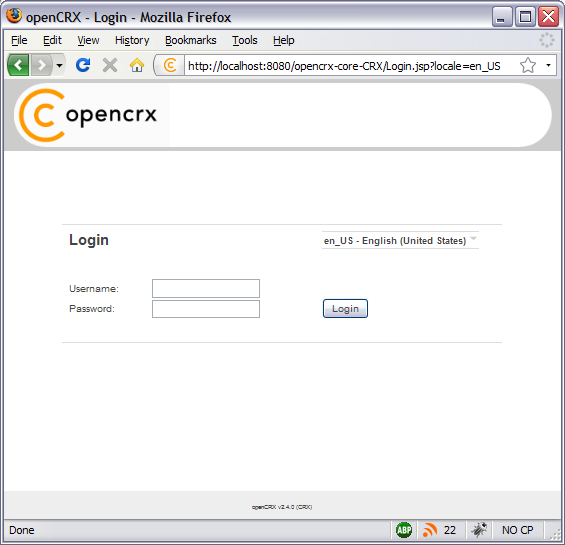
Figure 1: openCRX Login page
|
|
openCRX tries to determine the locale from your environment. You can change the locale at any time with the drop down on the login page. |
4.1.1 First Login as “admin-Root”
Enter admin-Root into the field Username and then enter opencrx into the field Password (obviously, if you chose a different password when you created the file tomcat-users.xml you have to enter that password...):
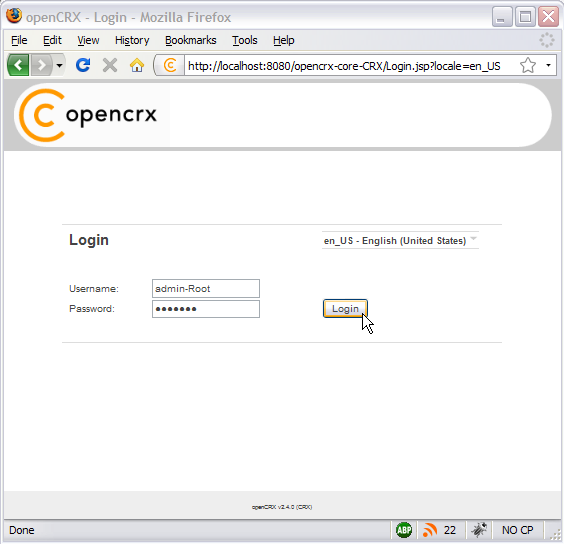
Figure 2: First login with admin-Root / opencrx
Click the button
![]() to start the initialization process.
to start the initialization process.
|
|
If you can't get past the login screen (with the correct Username and Password, of course) and the Warning “Browser must accept cookies” keeps showing up need to verify your browser settings related to cookies. If you have installed a personal firewall (e.g. ZoneAlarm, Comodo, etc.) you also need to verify the cookie settings of your firewall. Tomcat must be able to create/set a session cookie. |
The openCRX servlet is initialized during this first login, i.e. don't stop/kill the browser if it takes a while. The application console output will look similar to the following listing:
Listing 9: Console Output – Initialization of the openCRX servlet
Mon Mar 16 12:27:34 CET 2009: Login:
requestURL=http://localhost:8080/opencrx-core-CRX/Login.jsp;
isRequestedSessionIdFromCookie=false; servletPath=/Login.jsp;
remoteUser=null
Mon Mar 16 12:27:34 CET 2009: Login:
Redirecting...
Mon Mar 16 12:27:34 CET 2009: Login:
requestURL=http://localhost:8080/opencrx-core-CRX/Login.jsp;
isRequestedSessionIdFromCookie=true; servletPath=/Login.jsp;
remoteUser=null
Mon Mar 16 12:27:35 CET 2009: Login:
requestURL=http://localhost:8080/opencrx-core-CRX/Login.jsp;
isRequestedSessionIdFromCookie=true; servletPath=/Login.jsp;
remoteUser=null
Inspecting
/WEB-INF/config/ui/1-Easy/en_US
Inspecting
/WEB-INF/config/ui/1-Easy/de_CH
Inspecting
/WEB-INF/config/ui/1-Easy/es_MX
Inspecting
/WEB-INF/config/ui/1-Easy/zh_CN
Inspecting
/WEB-INF/config/ui/1-Easy/sv_SE
Inspecting
/WEB-INF/config/ui/1-Easy/tr_TR
Inspecting
/WEB-INF/config/ui/1-Easy/fa_IR
Inspecting
/WEB-INF/config/ui/1-Easy/fr_FR
...
...
Creating
org::openmdx::security::realm1/provider/CRX/segment/Root
Creating
org::openmdx::security::realm1/provider/CRX/segment/Root/realm/Default
Creating
org::openmdx::security::realm1/provider/CRX/segment/Root/realm/Default/principal/admin-Root
Creating
org::openmdx::security::realm1/provider/CRX/segment/Root/realm/Default/principal/Administrators
Creating
org::openmdx::security::realm1/provider/CRX/segment/Root/realm/Default/principal/Users
Creating
org::openmdx::security::realm1/provider/CRX/segment/Root/realm/Root
Creating
org::openmdx::security::realm1/provider/CRX/segment/Root/realm/Root/principal/Administrators
Creating
org::openmdx::security::realm1/provider/CRX/segment/Root/realm/Root/principal/Users
Creating
org::openmdx::security::realm1/provider/CRX/segment/Root/realm/Root/principal/admin-Root.User
Creating
org::openmdx::security::realm1/provider/CRX/segment/Root/realm/Root/principal/admin-Root
Loading
/WEB-INF/config/bootstrap/Root/103_security_authentication.xml
Storing
1 objects
Creating
org::openmdx::security::authentication1/provider/CRX/segment/Root
Loading
/WEB-INF/config/bootstrap/Root/200_code_segment.xml
Storing 1
objects
Creating
org::opencrx::kernel::code1/provider/CRX/segment/Root
Loading
/WEB-INF/config/bootstrap/Root/300_admin_segment.xml
Storing 1
objects
Creating
org::opencrx::kernel::admin1/provider/CRX/segment/Root
Loading
/WEB-INF/config/bootstrap/Standard/dummy.xml
Storing 0
objects
Done
Inspecting /WEB-INF/config/filters/
Loading
/WEB-INF/config/filters/
Loaded filters #5229
|
|
If you see lots of error messages on the console and/or your log files grow very fast (several hundred KB if not more) then it is quite likely that your DB connection is not configured correctly. If your log file contains errors like MEDIA_ACCESS_FAILURE there is definitely something wrong with your DB connection (or your DB). Please note that there is absolutely no sense in continuing before you have fixed your DB connection. You might want to verify
|
After the successful startup of openCRX you see a screen similar to the one shown in the figure below. You should see the root objects Administration, Codes, Security Realm, Security Policies, and Security Subjects:
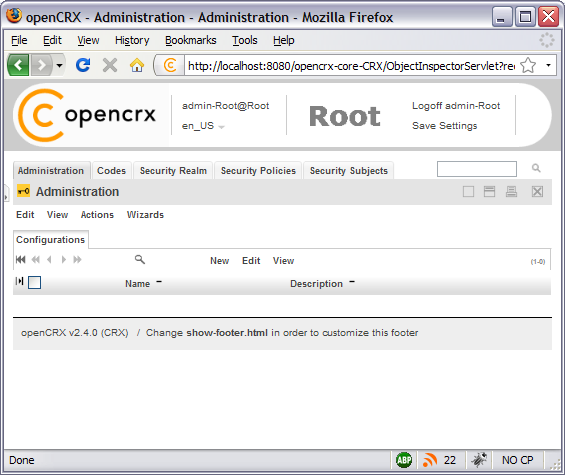
Figure 3: Start screen of admin-Root
4.1.2 Create Data Segment “Standard”
Execute the operation Actions > Create Administrator to create a new segment and selected default accounts (including an administrator's account which allows you to manage the newly created segment).

Figure 4: Create a new segment with Actions > Create Administrator
Set the field Segment name to Standard. Leave the field Admin principal name empty and set the fields Initial password and Password again to opencrx as shown in the figure below:
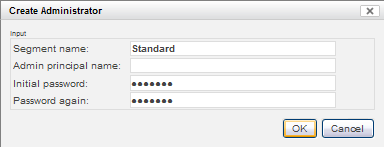
Figure 5: Create a new segment named Standard
|
|
Please verify the spelling/capitalization of
the segment name: |
Next you click OK to create the segment Standard and the segment administrator admin-Standard. The result of executing this operation should look as follows (Status 0 indicates that there were no errors):

Figure 6: Result of operation Create Administrator
4.1.3 Import Codes and Data
openCRX is distributed with many code tables and several data files (e.g. unit of measurement information, activity management process). Code tables and data files must be imported from the provided XML files to make them available to openCRX.
Execute the operation View > Reload and then click OK to start the import:
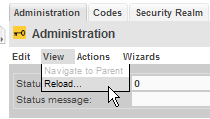
Figure 7: Load Code Tables and Data – Step 1

Figure 8: Load Code Tables and Data – Step 2
Please note that this operation takes some time to complete as thousands of objects are made persistent in your database during the import. The console output will look similar to the following listing:
Listing 10: Console Output – Importing Codes and Data
...
Loading codes
Loading
/WEB-INF/config/code/Root/en_US/accesslevel.xml
Loading
/WEB-INF/config/code/Root/en_US/accountcategory.xml
Loading
/WEB-INF/config/code/Root/en_US/accountrole.xml
Loading
/WEB-INF/config/code/Root/en_US/accountroleContract.xml
Loading
/WEB-INF/config/code/Root/en_US/accountroleInventoryItem.xml
Loading
/WEB-INF/config/code/Root/en_US/accountstate.xml
...
Loading
/WEB-INF/config/code/Root/ro_RO/usageproductbaseprice.xml
Loading
/WEB-INF/config/code/Root/ro_RO/utcoffset.xml
Storing 1626 code
entries
Done
Loading data
Loading
/WEB-INF/config/data/Root/100_uom_schedules.xml
Storing 4
objects
Loading /WEB-INF/config/data/Root/101_uoms.xml
Storing
39 objects
Done
Inspecting
/WEB-INF/config/ui/1-Easy/en_US
Inspecting
/WEB-INF/config/ui/1-Easy/de_CH
...
Loading 63 ui files for
locale es_CO
Loading 67 ui files for locale sk_SK
Loading 68
ui files for locale ro_RO
Storing 3115 ui elements
Inspecting
/WEB-INF/config/filters/
4.1.4 Set Access Levels of Codes
Navigate to the package Codes by clicking on the tab [Codes]. Then execute the operation Security > Set Access Level as shown below:
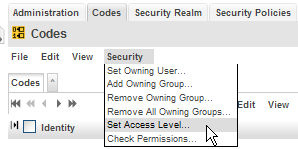
Figure 9: Execute Operation Security > Set Access Level
Set the parameters as shown below and then click OK:
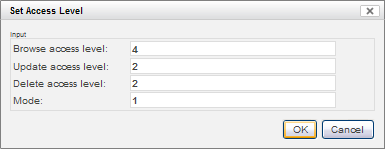
Figure 10: Parameters of Operation Set Access Level
Please note that this operation also takes a fair amount of time to complete:

Figure 11: Result of the Operation Set Access Level
The number in the status messages indicates the number of code values processed (you might get a different number, which is not a problem).
4.1.5 Restarting Tomcat
Please stop Tomcat by typing <CTRL>-C into the command window.
|
|
In case you're starting Tomcat without the help of a batch file that cleans Tomcat's tmp and work directories, it is strongly advised that you clean them by hand before you start Tomcat again! |
On Windows you can start Tomcat by executing TOMCAT_HOME\bin\run.bat, on Linux you execute TOMCAT_HOME\bin\run.sh.
4.2 Initial Setup of Segment “Standard”
Once Tomcat is up and running again, we configure the new segment and create a new user guest.
4.2.1 First Login as “admin-Standard”
Connect to the login page of openCRX. The exact URL depends on your deployment details. For a standard openCRX deployment to JBoss running on your local machine and listening at port 8080 the URL is
http://localhost:8080/opencrx-core-CRX/Login
You should see the openCRX Login page. Enter admin-Standard into the field Username and then enter opencrx into the field Password (you may have chosen a different password, i.e. enter the password you chose when you created the segment):
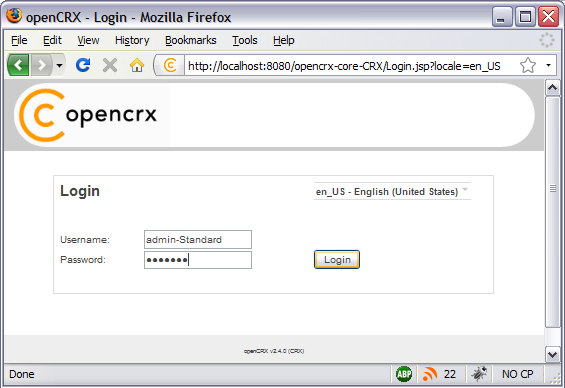
Figure 12: First login with admin-Standard / opencrx
Click the button
![]() to start the login process.
to start the login process.
The ObjectInspectorServlet is initialized during this first login after restarting Tomcat, i.e. don't stop/kill the browser if it takes a while.
|
|
Please note that charts are not displayed when a users logs in for the first time. Activate charts by executing the operation View > Recalculate and Refresh. |
4.2.2 Configure Segment “Standard”
Once the admin-Standard's homepage is displayed, start the wizard Segment Setup. Select the menu Wizards > Segment Setup as shown below:

Figure 13: As admin-Standard start the wizard Segment Setup
This wizard verifies all the default objects of a segment. Running it on a newly created segments results in a lot of red crosses. Click the button [Setup] and the wizard will create all the missing objects (the red crosses will change to green check marks as shown below):
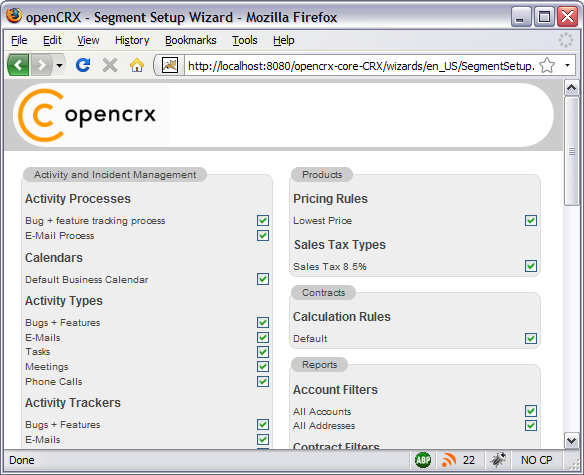
Figure 14: Wizard Segment Setup - properly configured Segment
Click on the button [Cancel] to leave the wizard and return to the homepage of the user admin-Standard.
4.2.3 Create a new Contact “guest”
Refresh the homepage of the user admin-Standard by clicking on the icon as show below:

Figure 15: Refresh homepage of user admin-Standard
Hover your mouse over the fly-in tab to show the following menu:
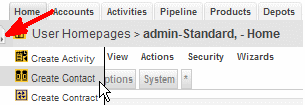
Figure 16: Fly-in menu
Choose the entry Create Contact and click on it.
You will see an empty form ready to be populated with the data of our new user guest. At a minimum you must provide a last name, e.g. guest as shown below:
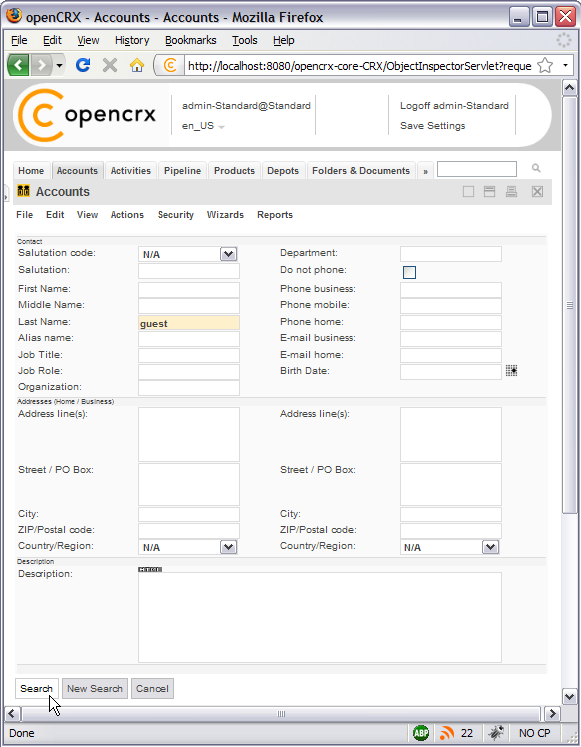
Figure 17: New contact guest – step 1
Next you click on the button [Search]. openCRX will verify that you don't already have a user with the same last name (but as we are working with a new/empty database this search doesn't bring up anything, of course). Now you can create the new contact by clicking on the button [Create New]:

Figure 18: New contact guest – step 2
As we don't want to create activities, leads or any other objects for our new contact, we now click [Cancel] to leave the wizard:

Figure 19: New contact guest – step 3
openCRX takes us back to the Accounts grid where we see the newly created contact guest:
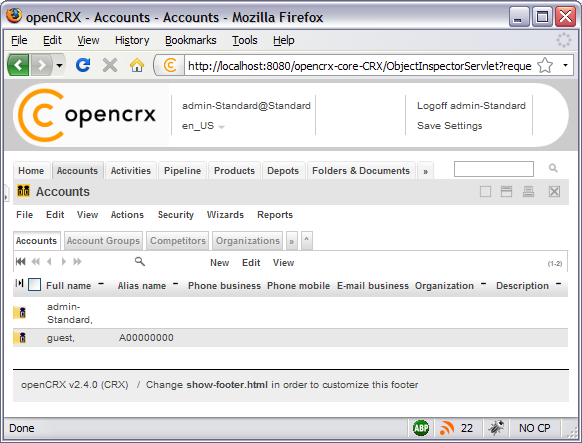
Figure 20: New contact guest – step 4
4.2.4 Create a new User “guest”
Click on the (hidden) tab [User Homepages]:
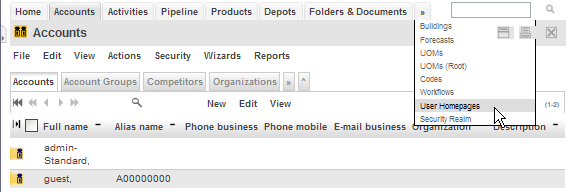
Figure 21: New user guest – step 1
Next you select the operation Actions > Create User... which allows you to create and initialize a new user:

Figure 22: New user guest – step 2
Set the fields to the values as shown below – type guest into the field Principal name, use the Lookup Inspector or the auto-completer to fetch values for Contact and Primary user group (note that you must either fetch values with the Lookup Inspector or select entries from the auto-completer's drop down menu for the parameters Contact and Primary user group, i.e. it is not sufficient to just type some text into these fields), and then type a password (e.g. opencrx) into the fields Initial password and Password again:
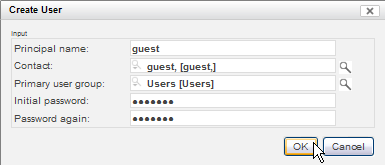
Figure 23: New user guest – step 3
Status 0 indicates that the user guest was created without errors:

Figure 24: New user guest – step 4
Next we navigate to the homepage of the newly created user guest by clicking on the icon as show below:
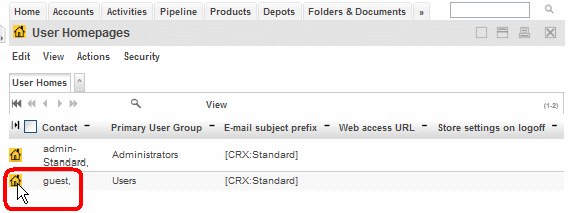
Figure 25: New user guest – step 4
Please note that we are still logged in as admin-Standard (as shown in the header of the application), but we are looking at the homepage of the user guest. Select the operation Edit > User Settings and click on it:
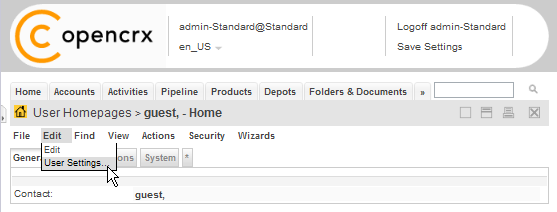
Figure 26: New user guest – step 5
This will start the wizard User Settings. You can configure various settings with this wizard. At a minimum you should probably set the timezone and enter the new user's e-mail address. Once you're done you can click the button [Apply]. The wizard will then create a bunch of objects and finalize the initialization of the user guest:
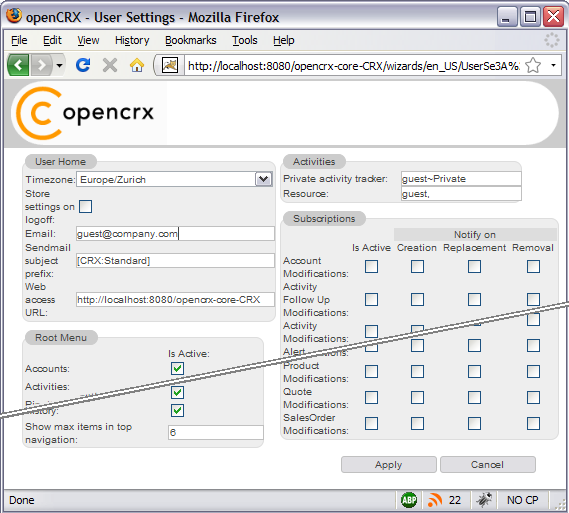
Figure 27: New user guest – step 6
Click [Cancel] to leave the wizard and then logoff as admin-Standard.
|
|
The wizard User Settings created a user group <username>.Group, in our case guest.Group. The primary user group of our user guest was automatically set to this new user group guest.Group. If you want to change the primary user group to anything else or if you ever must reset a user (lost password, etc.), you can re-execute the operation Create User as admin-Standard at any time. If you want to reset a user without changing the user's password, you can simply leave the password fields empty when recreating the user. |
4.2.5 Login as “guest”
Let's verify whether our new user guest can actually login. Enter guest into the field username, opencrx into the field password, and then click [Login].
You should now see the homepage of the newly created user guest. Initialize the charts by executing the operation View > Recalculate and Refresh:
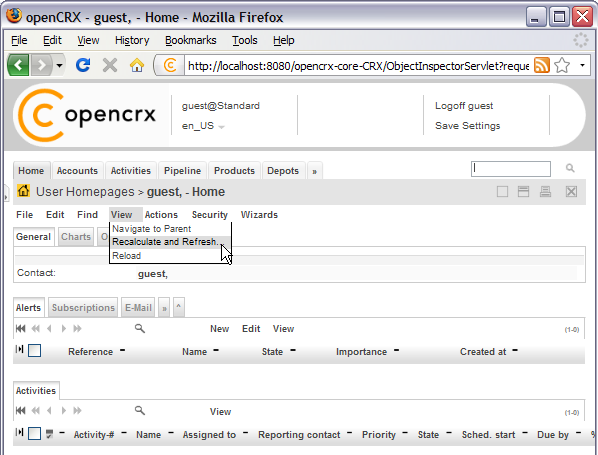
That's it – you have successfully completed the installation and initialization of openCRX and you have also created a user guest.
5 Next Steps
Now that you have successfully installed and configured openCRX you might want to have a look at some of the additional documentation published at http://www.opencrx.org/documents.htm.
License
The contents of this file are
subject to a BSD license (the "License"); you may not use
this file except in compliance with the License. You may obtain a
copy of the License at http://
Copyright 2009 ©
CRIXP Corp. All rights reserved. ![]()

